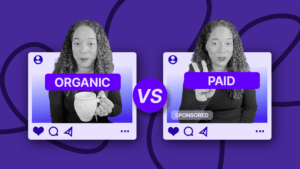Types of UGC Content [Elevate Your Brand At Every Stage]
With over 7 years of e-commerce experience, Agne has mastered the balance of creativity and performance. From guiding social media strategies to crafting high-converting ads, she’s all about results.

User-generated content (UGC) is a powerful tool brands can use to communicate with audiences on a deeper level. It offers a more authentic connection than conventional marketing, driving sales.
However, it isn’t all the same. Instead, UGC comes in different forms and offers value that depends on the setting.
For example, unboxing videos make sense in some contexts while social media takeovers are better in others.
So, what’s out there, and which should you use?
That’s the topic of this post. It explores how you can unlock UGC’s power using diverse approaches and when to use them.
Reviews and Testimonials: Building Trust Through Feedback
Reviews and testimonials are the first port of call for many brands wanting to leverage UGC. These are an obvious way to get products in front of audiences and build trust.
Billo offers a ready-made testimonial service that makes it more straightforward to get feedback from creators. It simplifies the creation process by making it possible to order testimonials in minutes and find matching influencers for your brand. You can showcase your products and start driving sales straight away without waiting for organic reviews to appear on third-party sites.
Reviews and testimonials are effective because they build trust. Creators present themselves as users’ peers, showcasing their personal experiences with products without corporate jargon or unrealistic polish.
One of our creators, Chris, does this exceptionally well when covering an Acer sound bar. He talks about its features and how it performs, giving users confidence about buying it without sounding overtly sales-driven.
Sierra does something similar for wireless headphones. She pairs her UGC with upbeat background music while discussing why she likes using the product.
Reviews and testimonials are effective because they offer the ultimate social proof. If users can see how others are having positive experiences with your brand, they will believe they can, too. Most people follow the actions of influencers they trust when selecting products. The UGC content builds engagement in the community. Customers with shared experiences gain a sense of belonging and want to join others in buying specific products.
Unboxing Videos: Creating Product Excitement
Unboxing videos have a different emphasis from reviews. This UGC type aims to generate excitement instead of evaluating features.
Billo offers extensive guidance and advice on creating unboxing videos. We explain you can use this now-mainstream trend for your brand. You can find creators on our platform to provide this UGC type, whether you sell tech gadgets or baby clothes.
The primary purpose of unboxing videos is to generate product excitement. Instead of going into details, creators attempt to generate interest in specific items, encouraging users to go deeper.
Billo creator Courtney does this well when opening a comfortable baby bath concept from Blooming Bath. The product fits in any sink or bathtub and allows parents to wash their children safely.
At first blush, watching someone else unbox a product seems strange. But despite the weirdness, it works as a marketing strategy for most brands.
For example, unboxing triggers the brain’s anticipation and reward circuits. Some prospective customers derive a psychological thrill from seeing someone else open a product, similar to what they would experience if they received a gift. Often, this sensation persists throughout the video, allowing the creator to talk about the product and how it works.
Viewers also get deeper insights into how the item works and what it looks like once it leaves the box. This perspective is often missing from conventional marketing images because they don’t convey all the essential details. Users can build firmer expectations and avoid disappointment if they go ahead and buy.
Billo’s New York-based creator, Chelsea, shows this concept in action when unboxing an advanced rice cooker. She talks about how it makes the process of cooking rice easy and that it comes with a warm function, meaning owners don’t have to check it every five minutes.
Lastly, some audience members even experience a dopamine release during unboxing. These generate feelings of joy, making the content more emotionally appealing, and encouraging them to return for more. For many, it is about “aspirational” viewing. Consumers watch unboxing videos of luxury products they can’t buy today but want to purchase in the future.
Tutorials and How-Tos: Educational UGC for Your Brand
Tutorials and how-tos are another form of UGC taking the world by storm. These offer more in-depth product information, showing audiences how to make the most of the items they buy.
Again, you can ask Billo creators to generate long-form explainer content following your briefs. Our influencers discuss your products and services in detail, making them more accessible.
Billo influencer, David, shows what this looks like in practice for a budgeting app. He explains how simple the solution is and lets him keep track of his monthly spending.
Tutorials work because they are cost-effective and relatable. Such UGC practice allows consumers to see products used in a real-world context, making them more engaging for potential buyers. Each creator has a unique perspective and will highlight different aspects the underlying brand wants to sell. For example, they might like a specific feature that resonates with their audience or gives them more capabilities.
As you produce more UGC tutorials and explainer videos, you will notice it increases customer engagement. Users are more likely to gather around you if you generate content about how to make the most of your products and services. Educated shoppers often enjoy interactive learning, boosting adoption.
Lastly, you can use UGC tutorials to understand customers’ needs better. Creators often provide feedback on their difficulties with using them, allowing you to make improvements. You can determine whether you need to change anything or if their experiences are typical.
Billo makes this process more straightforward by linking you to multiple creators. If you have a sample of influencers, you learn if an issue is an isolated problem or a broader-ranging incident.
Social Media Takeovers: Giving Creators the Spotlight
Social media takeovers are another common option for companies wanting to leverage UGC. These occur when an influencer takes over the brand’s social media account for the day (or some predefined period) and makes it their own.
Getting this right requires identifying the right users or customers. Ideally, it should be someone who already loves your products and feels committed to your brand’s identity.
The more you can promote takeovers beforehand, the better. Getting your audience pumped about interacting with their favorite influencer can help you make them more engaged in the upcoming event.
Social media takeovers work because they strengthen your brand’s relationship with shoppers. You can engage with real users to foster a deeper connection with your audience. Takeovers make them feel like they are part of your journey and steering your company toward the brand they want it to be.
These interactions can be two-way. Brands can engage with users in real time, and vice versa. You can even set up arrangements to co-host social media channels with influencers, bouncing ideas off each other.
However, social media takeovers can help for other reasons. For example, you can use them to:
- Connect with influencers with different audiences to bring them into your fold, building momentum
- Look for specific takeovers that are likely to make your channels go viral (i.e. hiring a controversial figure who people wouldn’t expect)
- Leverage users’ creativity to add a new angle to your brand that your internal marketing team might not consider alone
- Lower production costs by providing new styles and perspectives that don’t require you to invest in them
- Align your brand with a new culture or demographic, allowing you to reach hard-to-access clientele (i.e. people under 25)
- Community building to create a novel experience that audiences can’t find elsewhere.
You can kill many birds with one stone when using social media takeovers. For example, you could find a controversial figure to take over your account who also appeals to young audiences more than your conventional advertising.
Again, you can use Billo’s search features to discover these individuals. Granular filters let you find influencers who can meet all your social media takeover requirements.
Behind-the-Scenes Content: Humanizing Your Brand
Finally, behind-the-scenes content is another UGC strategy you can use to thrill shoppers and boost conversions. It provides glimpses into what goes on at your business so customers can go deeper with you.
Behind-the-scenes UGC comes in many forms. Some companies believe social media campaigns are the best approach. These occur when users go to VIP company events and share their experiences with their audiences. Prospects get a new and different perspective of your brand at minimal expense to you.
Live streams are another option. These let creators connect with fans in real-time while experiencing some aspect of your brand, such as:
- What it’s like to work creatively in your offices
- How craftspeople at your firm construct products
- The research and development that goes into creating your formulations
Time-lapse videos are sometimes helpful here, depending on the business. For example, UGC creators could cover the construction of a home extension, makeup sessions before and after, or cleaning transformations.
Behind-the-scenes UGC’s primary benefit is that it humanizes your brand. It gives your audience a glimpse into your operations and the people running the show. You can help them learn more about the incredible work that goes into creating what you make, driving trust and authenticity.
However, this UGC is also useful for creating a sense of exclusivity. It teaches fans to feel privileged that you are willing to show them how you operate, creating a sense of excitement and reciprocity. Prospects appreciate you taking the time to indulge their curiosity and provide information that wasn’t previously in the public domain.
Which UGC Type is Best for Each Stage of the Customer Journey?
Knowing which UGC type is best for each customer journey stage can help tremendously. However, you can slot multiple approaches discussed above into each category, so feel free to mix and match.
Awareness
To generate awareness, you can use:
- Unboxing videos
- Social media takeovers
These introduce consumers to your product and excite them about what you sell.
Billo’s Deidre does this well. She explains a new hair removal product that’s cordless and easy to hold, talking to users about how it works and why it benefits people.
Social media takeovers do something similar, building awareness on a broader scale. New audiences can learn about how a brand operates through their preferred influencer, increasing engagement and fresh content.
Consideration
UGC for generating consideration includes:
- Tutorials
- How-to videos
- Reviews
- Testimonials
The purpose of this stage of the sales funnel is to shift the customer from thinking about buying to handing over the money. As such, social proof and overcoming pain points become more critical.
Billo creator, Ana, has an explainer on a shampoo that makes hair stronger and shinier with just one wash. It explains why people should use the product and how it can change how they feel about the way they look.
Reviews are also an excellent option. For example, Billo’s Laura covers the effectiveness of a new over-40-friendly makeup brand that helps women in similar situations. She talks about how it provides coverage and avoids caking, an issue for some concealer products.
Decision And Retention
Lastly, you can use UGC for decision and retention, including:
- Behind-the-scenes conten
- Tutorials
- Testimonials
Behind-the-scenes content can build customer loyalty because it rewards individuals who take the time to follow you. It shows them how you operate, giving them peace of mind, and encouraging them to stay with you over alternative brands offering lower prices.
Tutorials do something similar. These show your audience you care about their long-term enjoyment of your product or service.
Finally, testimonials are often the lynchpin that holds your entire UGC campaign together. These provide mountains of social proof to encourage new customers to convert and bite the bullet.
Continue learning:
Creative Manager
With over 7 years of e-commerce experience, Agne has mastered the balance of creativity and performance. From guiding social media strategies to crafting high-converting ads, she’s all about results.
![Types of UGC Content [Elevate Your Brand At Every Stage]](https://billo.app/wp-content/uploads/2025/05/blog-banner-img-2-.webp)
Authentic creator videos, powered by real performance data
22,000+ brands use Billo to turn UGC into high-ROAS video ads.
Common UGC Brief Mistakes Brands Still Make in...
A vague or overpacked brief derails campaigns before they start, [...]...
Read full articleOrganic UGC vs Paid UGC: How Top Brands Drive Gr...
More brands are turning to user-generated content (UGC) to fuel [...]...
Read full articleOrganic UGC: How to Turn Native Creator Posts in...
Short-form feeds spotlight content that feels natural, not like ads. [...]...
Read full article![Types of UGC Content [Elevate Your Brand At Every Stage]](https://billo.app/wp-content/uploads/2025/05/banner-img.webp)
![Types of UGC Content [Elevate Your Brand At Every Stage]](https://billo.app/wp-content/uploads/2025/05/banner-mobile-img.webp)


